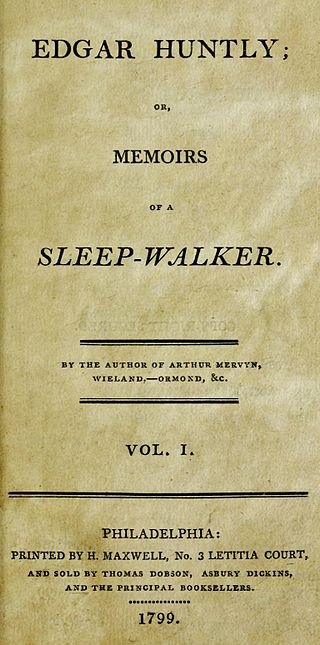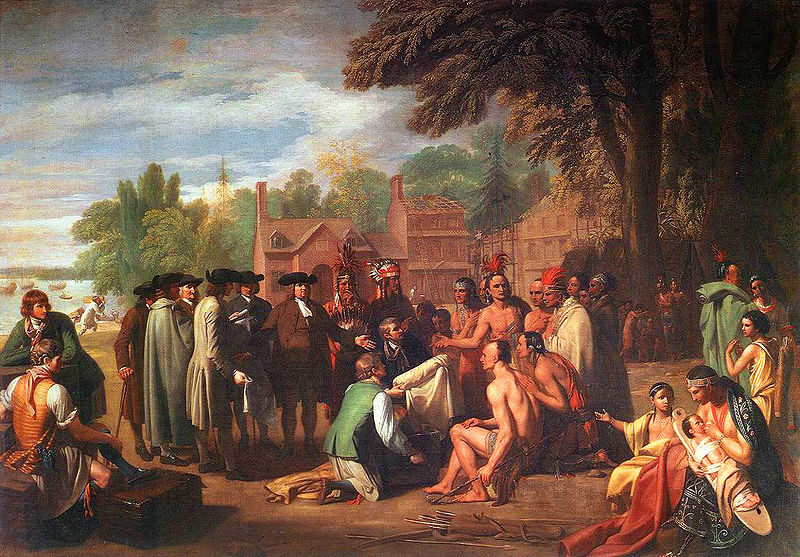Background
American author Charles Brockden Brown wrote his gothic novel Edgar Huntly or, Memoirs of a Sleep-walker in 1799. Perhaps what makes this novel notable from his other gothic fiction is the content of its preface. In the preface, Brown explains the uniqueness of the American gothic as compared to the European gothic. He states that Edgar Huntly was written by using “the condition of our country” as well as “one of the most common and most wonderful diseases or affections of the human frame” (3). In separating the American from the European gothic, he states,
One merit the writer may at least claim; that of calling forth the passions and engaging the sympathy of the reader, by means hitherto unemployed by preceding authors. Puerile superstition and exploded manners; Gothic castles and chimeras, are the materials usually employed for this end. The incidents of Indian hostility, and the perils of the western wilderness, are far more suitable; and, for a native of America to overlook these, would admit of no apology. (3)
Plot Summary
Edgar Huntly, a young educated man living just outside of Philadelphia with his two sisters and uncle, writes to his beloved Mary about his adventures seeking to discover the person who murdered her brother and his best friend, Waldegrave. Edgar quickly notices the odd behavior of a neighboring Irish servant, Clithero, who sleep-walks and digs near the same elm tree where Waldegrave was murdered. Upon investigating Clithero, Edgar learns that Clithero feels great guilt, but about a much different situation. While in Ireland, Clithero was rescued from poverty by the rich Mrs. Lorimer and set to marry her daughter, Clarice. Unfortunately, by a collection of unfortunate events, Clithero murders Mrs. Lorimer’s evil brother Arther Wiatte in an act of self-defense and is caught trying to kill Mrs. Lorimer in order to preserve her from this horrible knowledge and her supposed linked fate with her brother. Clithero seems suicidal, and indeed he tries to kill himself through isolating and starving himself in the wilderness. Desperate to help his fellow man, Edgar seeks him out. One night, after Edgar hoes to sleep in his own bed, he wakes up in a cave. In his quest to find his way home, he survives a panther attack (and eats the panther’s flesh and blood!), rescues a young female captive, and kills numerous Lenni Lenape Indians. He finally finds his way home and meets with Sarsfield, his old tutor and, as it turns out, Mrs. Lorimer’s husband. The Lenni Lenape were starting a war against the white settlement, led by Old Deb. It was a member of this tribe who murdered Waldegrave. Unfortunately for Edgar, Sarsfield refuses to forgive Clithero. Edgar reveals to Clithero that Mrs. Lorimer and Clarice followed Sarsfield to American and discloses their location. Clithero has gone mad and proceeds to journey to Mrs Lorimer, who accidentally receives this information and undergoes a miscarriage as a result. Sarsfield seeks to have Clithero captured and put into an asylum in Pennsylvania. However, Clithero evades capture and jumps into the ocean, most likely killing himself.

The title page of the first edition of Edgar Huntly
Notes & Quotes
- Class and appearance: Similar to Carwin in Brown’s Wieland, Clithero is born poor but is able to appear as a member of a higher class. Clithero’s ability to change his appearance is far less insidious than Carwin’s, however, it still seems uncanny. Clithero was taken in and educated by Mrs. Lorimer, who eventually even accepted him as a suitable husband for her adopted daughter Clarice. When Clithero leaves and becomes a servant of Inglefield. In this position, he remains an oddity because of his education and polished behavior. His outward appearance is now rough and rustic, but his inner self is far more cultivated. In this end, this sort of movement within society appears destructive for poor Clithero who desperately desires to kill himself due to his guilt conscious at first, and then because of his madness and aversion to being placed in an asylum.
- The Ecogothic: There is SO MUCH ecogothic in this novel! Throughout the story, Clithero and Edgar (who are gothic doubles) are often blended into the wilderness, while panthers take on human characteristics. The crime scene of Waldegrave’s murder is in nature, right next to an elm tree. During one of his first times approaching the elm, Edgar notices “somewhat else, which made itself distinguishable by its motions… To a casual observer this appearance would have been unnoticed” (9). This thing was a half-naked Clithero. In the midst of his quest returning home, Edgar thankfully happens upon a house, as well as a few of its residents: a woman and her two children. Unfortunately, these people initially display great terror at Edgar’s appearance:
The uncouthness of my garb, my wild and weather-worn appearance, my fusil and tom-hawk, could not but startle them. The woman stopt her wheel, and gazed as if a specter had started into view. (196)
Additionally, just before Edgar contends with the first panther, he is forced to dispose of a number of his man-made items. The panther itself is described in very human terms:
…a cry which he at that moment uttered, and which, by its resemblance to the human voice, is peculiarly terrific. (118)
In the footnote, this panther is described as being “the grey Cougar,” an animal which is “equally formidable to man.” This particular panther almost immediately notices the bridge which Edgar had made and considers using it. Although Edgar does use guns during the novel, he notes during this scene that he is the “master” of the “Tom-hawk,” a more pre-technological weapon that is more aligned to the American Indians than to the white Americans.
Just before his encounter with the second panther, Edgar descends into an animal-like state and deals with a great desire to “bite the flesh from my arm…and I pondered on the delight I should experience in reining some living animal to pieces, and drinking its blood and grinding its quivering fibres between my teeth” (156-7). After he kills the panther with his tomahawk, he eats the animal:
The first suggestion that occurred was to feed upon the carcass of this animal… I review this scene with loathing and horror. Now that it is past I look back upon it as on some hideous dream. The whole appears to be some freak of insanity. No alternative was offered, and hunger was capable to be appeased, even by a banquet so detestable… it will not excite amazement that I did not turn from the yet warm blood and reeking fibres of a brute. (159-60)
This moment reminded me a lot of Mary Rowlandon’s captivity narrative, particularly the scene in which she eats the horse-hoof meat. It is also reminiscent of the cannibalism fantasy he describes just prior to this moment. It’s interesting how he connects his bewilderment (this word is used multiple times to describe his state) through a question of sanity and madness. Brown himself argued for suicidal prevention and treatment to occur through “reinvigorating the sense of social duty among the abject to live and serve the republican project” (Vallee 335). Isolation and abjection, according to Brown, would only make the urge to kill oneself stronger, however, if all citizens felt a moral obligation to continue living and serving America, then they’d be less likely to commit the deed. In this scene, Edgar is completely alone in nature (besides the animals and Indians he encounters) and therefore begins to loose himself. He maintains his humanity through moments of service, such as his continued desire to save Clithero from suicide and isolation, as well as his courageous rescue of the young female prisoner.
After eating the panther, however, Edgar experiences great stomach pains. Thankfully, these pains eventually leave him and he feels stronger than he did prior to the wild meal. He states,
Had I fore-known the pangs to which my ravenous and bloody meal would give birth, I should have carefully abstained, and yet these pangs were a useful effort of nature to subdue and convert to nourishment the matter I had swallowed. (161)
I wonder if this is Brown’s own commentary on the American wilderness, which was dangerous and difficult to deal with initially, however, once cultivated, provided European colonists with a desirable land on which to create the new nation.
